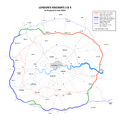M25 motorway facts for kids
Quick facts for kids
M25 motorway |
|
|---|---|
| Lua error in Module:Infobox_road/map at line 15: attempt to index field 'wikibase' (a nil value).
M25 highlighted in dark blue.
|
|
| Route information | |
| Part of |
|
| Length | 117 mi (188 km) |
| Existed | 1975–present |
| History | Completed 1975-1986 |
| Major junctions | |
| Orbital around London | |
| From | Hawley (near Dartford) (A2) |
J2 → M2 motorway
J12 → M3 motorway Junction 2 J15 → M4 motorway Junction 4b J16 → M40 motorway Junction 1a J21 → M1 motorway Junction 6a J23 → A1(M) motorway Junction 1 J27 → M11 motorway Junction 6 |
|
| To | West Thurrock (A13) |
| Location | |
| Primary destinations: |
London, Dartford, Sevenoaks, Reigate, Staines, Heathrow Airport |
| Road network | |
|
|
The M25 motorway, also known as the London Orbital, is a major road that circles Greater London. It is about 117-mile (188 km) long.
People first thought about building a road like this in the early 1900s. Some parts were built in the 1970s. The entire M25 was finished in 1986. It is one of the longest circular roads in the world.
The M25 is one of the busiest roads in Britain. Near London Heathrow Airport, 196,000 vehicles were counted on a single day! It connects London's four main airports: Heathrow, Gatwick, Stansted, and Luton.
Since no motorways go through central London, the M25 is a key route. It helps people travel between the north, south, east, and west of England.
When it was first built, the M25 had six lanes (three in each direction). Experts had suggested it needed eight lanes. Now, most of the motorway has four lanes in each direction. Some special sections have even more. Work is still ongoing to improve the road.
Contents
Planning the M25 Motorway
Planning the M25 involved many public meetings in the 1970s and 1980s. Each part of the road had its own meeting. Local people and groups could ask questions about the plans.
There were 39 public meetings in total. They took over 700 days to complete. People who disagreed with the plans could suggest other ideas. Each of these ideas had to be carefully considered.
The plans also had to go to Parliament. A special law was needed to build a tunnel under Epping Forest. This was because the road crossed the northern part of the forest.
How the M25 Has Changed Over Time
As experts predicted, the M25 became very busy soon after it opened in 1986. By 1990, the government announced plans to make the whole M25 wider. They wanted to add a fourth lane.
The motorway was designed for 88,000 vehicles per day. But by 1993, it was carrying 200,000 vehicles daily! About 15% of all UK motorway traffic used the M25.
In 1995, a system called MIDAS was added to parts of the M25. MIDAS stands for 'Motorway Incident Detection and Automatic Signalling'. This system uses sensors to check traffic and weather. It also has speed cameras and signs that can change speed limits.
MIDAS helps traffic flow better and reduces stop-and-go driving. When variable speed limits are used, it's called a "controlled motorway". If the hard shoulder (emergency lane) is used during busy times, it becomes a "managed motorway".
There was a plan in 1995 to make a section near Heathrow Airport 14 lanes wide. Many people protested against this idea, and it was cancelled. Later, in 1997, new plans came out to widen a section near Heathrow to 12 lanes. This part of the M25 was completed in 2005.
Building Costs
The M25 cost about £1 billion to build in the 1980s. It took 11 years to finish. Workers used two million tons of concrete and 3.5 million tons of asphalt to build the road.
Dartford Crossing
The Dartford Crossing is a big problem area on the M25. It's in the east and causes traffic jams. Even though it's not officially part of the M25, it's a key link.
The crossing has a bridge for traffic coming from the north and a tunnel for traffic from the south. There are often long lines of cars waiting to cross in both directions.
How the M25 Changed Life
On its 25th birthday, the BBC talked about how the M25 affected life around London:
- New Businesses: The M25 helped businesses grow and spread out from London. Many new offices and shops have been built near the motorway. This area now has a huge amount of business space.
- Higher House Prices: Before the M25, areas outside London were mostly small farms or places where people lived to commute. The M25 made commuting easier. This caused house prices in these areas to go up a lot. Some experts say house prices have gone up about 300% since 1986. On the western side of London, prices have gone up even more, by about 400%.
- Changed Daily Life: The M25 changed how people plan their lives. It became much easier to travel around London. For example, someone who works at Heathrow Airport can now buy a house on the other side of London.
Images for kids
-
View north from Higher Denham Fire Station at Tatling End on the A40 in July 1984, with the Chiltern Main Line five-arch 1906 Chalfont Viaduct, originally built to straddle the River Misbourne
-
Inside the Bell Common Tunnel near Epping
-
The M4/M25 motorway junction (junction 15), near Heathrow Airport
-
Near Heathrow Airport, the M25 is six lanes wide in each direction.
See also
 In Spanish: Autopista M25 (Reino Unido) para niños
In Spanish: Autopista M25 (Reino Unido) para niños











